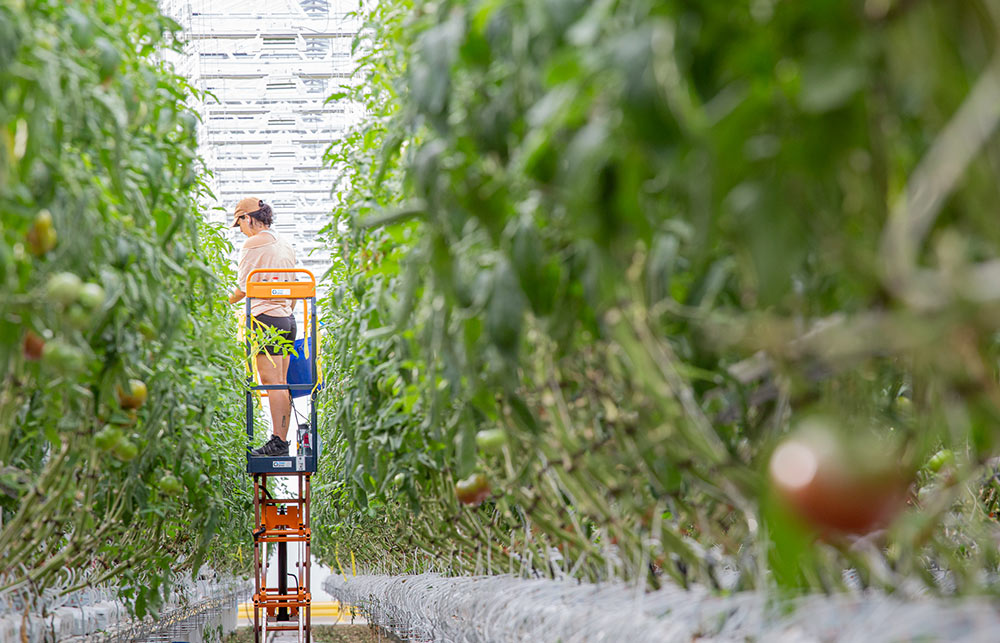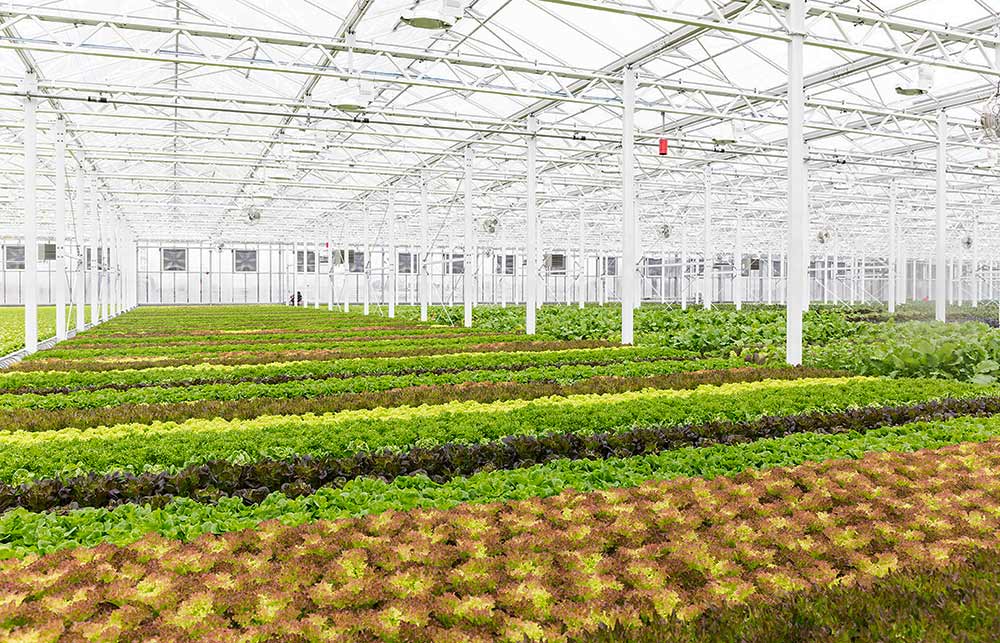
在蒙特利尔西北部的一个半工业社区中,有全球最大的商用屋顶温室,这里曾经是西尔斯百货(Sears)的仓库。每天早上,工作人员很早就开始采摘蔬菜,然后把它们送到楼下,与当天的其他食品杂货订单一起,装到结实耐用的塑料收纳筐中。
安装有定制分拣包装软件的平板设备,会告诉工作人员该把商品装到哪个收纳篮:这个篮子里有莴苣、西红柿和黄瓜,还有一些鸡肉、鸡蛋和牛奶。另一个篮子里装的是茄子、腰果巴马干酪、番茄酱、新鲜意大利面和素酥饼等。对于四个温室不出产的食物,Lufa会直接向本地农场和生产商采购,他们大部分都在100英里范围以内。
这是一位现代美食家的梦想:一家技术先进的在线购物平台,销售的都是本地种植的农产品,不使用杀虫剂,以合理的价格、用合乎道德的方式进行采购,这些农产品会每周一次送到消费者家门口或位于社区的自提点。
令人觉得不可思议的是,Lufa的两位创始人既没有种过西红柿,更没有销售农产品的经验。39岁的穆哈默德•海格在2009年与劳伦•拉斯梅尔合作创立了Lufa。他表示:“我们说:‘我们不必去了解食品行业是如何运行的,我们只要去思考在我们心目中食品行业该有的样子就行了。’”
他们心目中的食品行业是这样的:屋顶温室在城市中实现了农业种植。不使用杀虫剂、除草剂或者灭菌剂。绿色废弃物能够分解。在采摘当天可以直接销售给消费者。收集和重复利用雨水。食品外包装也是可以重复使用的。
这就是他们正在做的事情,而且在加拿大第二大城市蒙特利尔,他们用这份事业满足了部分人的需求。

在仓库里,工人对着平板设备核对放入收纳篮的商品。
Lufa将其客户称为“Lufa食品爱好者”,他们通常会提前几天通过名为“市集”(the Marketplace)的在线商店下订单,公司在2012年从零开始创建了这个平台。客户提前下订单,使Lufa供应商能够了解需要供应的商品数量:通过Lufa软件,他们首先会收到预测数据,之后会收到最终订单数量。冷冻肉等商品每周一次向仓库交货。面包等商品则每天送货,以保证新鲜。
蒙特利尔传统手工面包店la Fabrique Arhoma的共同所有人阿莉安娜•博蒙特告诉《财富》杂志,该面包店从大约六年前就已经开始向Lufa供应面包和点心。目前,该面包店每天为Lufa手工制作6,000件面包产品。博蒙特表示,给Lufa的供货目前占其商业销售额的30%至40%;自当地因疫情实施封锁令以来,许多本来发往餐厅的商品订单都转给了Lufa。博蒙特表示:“他们是一家优秀的公司。我们不清楚他们是如何运作的。而且他们付款的速度最快。”
公司两位创始人很清楚,技术是Lufa成功的基石。
32岁的拉斯梅尔表示:“我们自认为是一家科技公司,因为我们依靠软件来解决问题。”事实上,他们也没有其他选择。为了实现他们在2009年的梦想,他们只能自己动手。那时候还不像现在,因为新冠疫情,大部分食品杂货店开始提供在线购物。
拉斯梅尔表示:“当时我们要做的事情没有现成的解决方案,因为这件事太过复杂。我们要自己采摘;要向全省各地的农民和食品制造商采购;大部分商品要在夜里准时抵达仓库以便于白天装进储物筐,而且每一个订单都是独一无二的。”
Lufa现在有八名程序员负责软件和系统工作,这些系统用于管理电子商务、仓库、路线选择、客户关系、供应商订单、分拣包装、供应商付款、送达时间预估等。
这些技术在去年3月13日星期五经受了一次命运攸关的考验,当时魁北克和加拿大政府都宣布执行首轮新冠疫情封锁措施。民众陷入恐慌,并纷纷涌入食品杂货店囤积面粉和厕纸。
Lufa的“每周食品杂货购物篮”在线新注册人数激增,而且现有用户也开始增加订购商品的数量,但与此同时,Lufa的自提点却被迫关闭。拉斯梅尔回忆说:“我们的业务一夜之间翻了一番。” Lufa被迫超负荷运行,之前一直运转良好的系统和软件,当时也开始暴露出问题。
Lufa临时关闭了网站,并创建了一份等待清单。公司员工分析了疫情的发展趋势,以及他们如何做才能对各个步骤进行调整;重新布置仓库楼层以进一步隔开员工之间的距离;设置公司能够承受的接单量,然后重新开放网站,之后每周逐步扩大规模,直至达到他们往常的发货速度。目前,该公司每周可以处理25,000份订单。
海格和拉斯梅尔表示,以技术为主导的经营理念使他们在令人胆战心惊的疫情初期的运营,有足够的灵活性和策略性。经过数次重新校准和更新开发之后,公司的软件和程序现在可以处理更多客户、供应商和流程,这是公司继续扩大温室业务的关键。2020年8月,Lufa建立了第四座温室,占地面积增加了一倍。四座温室每周可以生产57,000磅食品。公司计划今年建立第五座温室。
海格表示:“Lufa的目标是能够服务这座城市里的所有人。”
在征服蒙特利尔之后呢?他们计划在北美洲东北部开辟第二个市场,理想情况是能在今年得到落实,但具体地点尚未最终确定。拉斯梅尔表示:“我们的未来愿景是在更接近人们居住地的地方,以更可持续的方式进行农业种植。”

将高产作物种植引入城市是一种明智的做法,能够解决现代环境和人类健康面临的诸多挑战。
麦吉尔大学(McGill University)农业与环境科学副教授马克•莱夫斯洛德指出,采用LED和自动化等技术在室内和城市温室中进行种植,可以缩短供应链,更好地保存食物营养,减少食物浪费,并降低气候变化的冲击。在主要使用低碳能源的城市(蒙特利尔依靠水力发电),室内种植和进口变成了更显而易见的选择。
莱夫斯洛德表示:“我在受控环境与温室行业工作了20多年,Lufa这样一家公司不仅引起了人们对于城市农业的关注,也让人们注意到了温室种植的重要性。”他补充说,Lufa的成功推动政府增加了对整个行业的投资。
他表示:“魁北克政府现在将其作为一项很严肃的事业,这意味着我的学生和我们在大学里所做的研究,现在能够创造就业,而且有可能建立起自己的体系。”
海格一直热衷于开发更垂直一体化的食物系统,因为这种理念不仅能减少生产加工环节的中间人,可以增加利润,还能提高食物的质量、可追溯性和食物生产的道德性。
海格表示:“你知道,每次我们跟别人谈起这种理念的时候,我们都感觉自己是在上世纪80年代,拿着一块巨大的太阳能面板试图说服房间里的人:它代表未来。”
随着农业整体上向垂直一体化方向转变,海格和拉斯梅尔似乎不再被视为有着疯狂梦想的疯狂科学家。相反,他们发出的是理性的声音,代表着食品行业的未来。(财富中文网)
翻译:刘进龙
审校:汪皓
在蒙特利尔西北部的一个半工业社区中,有全球最大的商用屋顶温室,这里曾经是西尔斯百货(Sears)的仓库。每天早上,工作人员很早就开始采摘蔬菜,然后把它们送到楼下,与当天的其他食品杂货订单一起,装到结实耐用的塑料收纳筐中。
安装有定制分拣包装软件的平板设备,会告诉工作人员该把商品装到哪个收纳篮:这个篮子里有莴苣、西红柿和黄瓜,还有一些鸡肉、鸡蛋和牛奶。另一个篮子里装的是茄子、腰果巴马干酪、番茄酱、新鲜意大利面和素酥饼等。对于四个温室不出产的食物,Lufa会直接向本地农场和生产商采购,他们大部分都在100英里范围以内。
这是一位现代美食家的梦想:一家技术先进的在线购物平台,销售的都是本地种植的农产品,不使用杀虫剂,以合理的价格、用合乎道德的方式进行采购,这些农产品会每周一次送到消费者家门口或位于社区的自提点。
令人觉得不可思议的是,Lufa的两位创始人既没有种过西红柿,更没有销售农产品的经验。39岁的穆哈默德•海格在2009年与劳伦•拉斯梅尔合作创立了Lufa。他表示:“我们说:‘我们不必去了解食品行业是如何运行的,我们只要去思考在我们心目中食品行业该有的样子就行了。’”
他们心目中的食品行业是这样的:屋顶温室在城市中实现了农业种植。不使用杀虫剂、除草剂或者灭菌剂。绿色废弃物能够分解。在采摘当天可以直接销售给消费者。收集和重复利用雨水。食品外包装也是可以重复使用的。
这就是他们正在做的事情,而且在加拿大第二大城市蒙特利尔,他们用这份事业满足了部分人的需求。
在仓库里,工人对着平板设备核对放入收纳篮的商品。
Lufa将其客户称为“Lufa食品爱好者”,他们通常会提前几天通过名为“市集”(the Marketplace)的在线商店下订单,公司在2012年从零开始创建了这个平台。客户提前下订单,使Lufa供应商能够了解需要供应的商品数量:通过Lufa软件,他们首先会收到预测数据,之后会收到最终订单数量。冷冻肉等商品每周一次向仓库交货。面包等商品则每天送货,以保证新鲜。
蒙特利尔传统手工面包店la Fabrique Arhoma的共同所有人阿莉安娜•博蒙特告诉《财富》杂志,该面包店从大约六年前就已经开始向Lufa供应面包和点心。目前,该面包店每天为Lufa手工制作6,000件面包产品。博蒙特表示,给Lufa的供货目前占其商业销售额的30%至40%;自当地因疫情实施封锁令以来,许多本来发往餐厅的商品订单都转给了Lufa。博蒙特表示:“他们是一家优秀的公司。我们不清楚他们是如何运作的。而且他们付款的速度最快。”
公司两位创始人很清楚,技术是Lufa成功的基石。
32岁的拉斯梅尔表示:“我们自认为是一家科技公司,因为我们依靠软件来解决问题。”事实上,他们也没有其他选择。为了实现他们在2009年的梦想,他们只能自己动手。那时候还不像现在,因为新冠疫情,大部分食品杂货店开始提供在线购物。
拉斯梅尔表示:“当时我们要做的事情没有现成的解决方案,因为这件事太过复杂。我们要自己采摘;要向全省各地的农民和食品制造商采购;大部分商品要在夜里准时抵达仓库以便于白天装进储物筐,而且每一个订单都是独一无二的。”
Lufa现在有八名程序员负责软件和系统工作,这些系统用于管理电子商务、仓库、路线选择、客户关系、供应商订单、分拣包装、供应商付款、送达时间预估等。
这些技术在去年3月13日星期五经受了一次命运攸关的考验,当时魁北克和加拿大政府都宣布执行首轮新冠疫情封锁措施。民众陷入恐慌,并纷纷涌入食品杂货店囤积面粉和厕纸。
Lufa的“每周食品杂货购物篮”在线新注册人数激增,而且现有用户也开始增加订购商品的数量,但与此同时,Lufa的自提点却被迫关闭。拉斯梅尔回忆说:“我们的业务一夜之间翻了一番。” Lufa被迫超负荷运行,之前一直运转良好的系统和软件,当时也开始暴露出问题。
Lufa临时关闭了网站,并创建了一份等待清单。公司员工分析了疫情的发展趋势,以及他们如何做才能对各个步骤进行调整;重新布置仓库楼层以进一步隔开员工之间的距离;设置公司能够承受的接单量,然后重新开放网站,之后每周逐步扩大规模,直至达到他们往常的发货速度。目前,该公司每周可以处理25,000份订单。
海格和拉斯梅尔表示,以技术为主导的经营理念使他们在令人胆战心惊的疫情初期的运营,有足够的灵活性和策略性。经过数次重新校准和更新开发之后,公司的软件和程序现在可以处理更多客户、供应商和流程,这是公司继续扩大温室业务的关键。2020年8月,Lufa建立了第四座温室,占地面积增加了一倍。四座温室每周可以生产57,000磅食品。公司计划今年建立第五座温室。
海格表示:“Lufa的目标是能够服务这座城市里的所有人。”
在征服蒙特利尔之后呢?他们计划在北美洲东北部开辟第二个市场,理想情况是能在今年得到落实,但具体地点尚未最终确定。拉斯梅尔表示:“我们的未来愿景是在更接近人们居住地的地方,以更可持续的方式进行农业种植。”
将高产作物种植引入城市是一种明智的做法,能够解决现代环境和人类健康面临的诸多挑战。
麦吉尔大学(McGill University)农业与环境科学副教授马克•莱夫斯洛德指出,采用LED和自动化等技术在室内和城市温室中进行种植,可以缩短供应链,更好地保存食物营养,减少食物浪费,并降低气候变化的冲击。在主要使用低碳能源的城市(蒙特利尔依靠水力发电),室内种植和进口变成了更显而易见的选择。
莱夫斯洛德表示:“我在受控环境与温室行业工作了20多年,Lufa这样一家公司不仅引起了人们对于城市农业的关注,也让人们注意到了温室种植的重要性。”他补充说,Lufa的成功推动政府增加了对整个行业的投资。
他表示:“魁北克政府现在将其作为一项很严肃的事业,这意味着我的学生和我们在大学里所做的研究,现在能够创造就业,而且有可能建立起自己的体系。”
海格一直热衷于开发更垂直一体化的食物系统,因为这种理念不仅能减少生产加工环节的中间人,可以增加利润,还能提高食物的质量、可追溯性和食物生产的道德性。
海格表示:“你知道,每次我们跟别人谈起这种理念的时候,我们都感觉自己是在上世纪80年代,拿着一块巨大的太阳能面板试图说服房间里的人:它代表未来。”
随着农业整体上向垂直一体化方向转变,海格和拉斯梅尔似乎不再被视为有着疯狂梦想的疯狂科学家。相反,他们发出的是理性的声音,代表着食品行业的未来。(财富中文网)
翻译:刘进龙
审校:汪皓
The world’s biggest commercial rooftop greenhouse sits atop a former Sears warehouse in a semi-industrial northwestern quarter of Montreal. Early every morning, staff pick fresh vegetables, then bring them downstairs, where they get packed into heavy-duty plastic totes along with the rest of the day’s grocery orders.
Tablets loaded with custom pick-and-pack software tell them where to put what: This basket has lettuce, tomatoes, and cucumbers, plus some chicken, eggs, and milk. The next one has eggplant, cashew Parmesan, tomato sauce, fresh pasta, and vegan ground round crumble. Whatever Lufa doesn’t grow in its four greenhouses comes from local farms and producers, mostly from within 100 miles.
This is a modern foodie’s dream: a tech-forward online shop full of locally grown, pesticide-free, ethically-sourced products at reasonable price points, delivered once a week to either your doorstep or a local pickup point in your neighborhood.
It’s stunning to think Lufa was founded by two people who’d never even grown a tomato before, let alone sold one. “We said, ‘Instead of learning how the food world works, let’s just come up with what we feel the food world should be,’” says Mohamed Hage, 39, who cofounded Lufa with Lauren Rathmell in 2009.
To them, it looked like this: rooftop greenhouses that bring agriculture into cities. No pesticides, herbicides, or fungicides. Composting their green waste. Selling direct-to-consumer the same day the food is harvested. Capturing and reusing rainwater. Reusable packaging.
That’s exactly what they now have—and they feed a portion of Montreal, the second-biggest city in Canada, with it.
Back in the warehouse, workers poke at their tablets, checking off items as they’re packed into the boxes.
Customers—Lufavores, as the company calls them—typically place their orders a few days before delivery through the online store, dubbed “the Marketplace,” which Lufa built from scratch in 2012. That’s how Lufa’s suppliers know how much product to provide: They get forecasts first, then final order numbers, through their Lufa software. Some items, like frozen meat, can be delivered to the warehouse once a week. Others, like bread, arrive fresh every day.
Artisanal Montreal bakery la Fabrique Arhoma started supplying Lufa with bread and pastries about six years ago, co-owner Ariane Beaumont tells Fortune. Today, they hand-make 6,000 individual items a day for Lufa. Beaumont said Lufa now accounts for between 30% to 40% of her commercial sales; since pandemic shutdowns, a lot of the product destined for restaurants got redirected to Lufa. “They’re an exceptional company. I don’t know how they do it,” Beaumont says. “And they pay the fastest, too.”
Technology is the underpinning of Lufa’s success, and the owners know it.
“We see ourselves as a technology company, in the sense that we solve with software,” Rathmell, 32, says. They didn’t really have any other choice. To fulfill that dream they had back in 2009—years before COVID-19 forced most grocery stores to enable online shopping—they had to do it themselves.
“Nothing off-the-shelf can be applied to what we do, because it’s so complex,” Rathmell notes. “We harvest food ourselves; we gather from farmers and food makers throughout the province; most of it’s arriving just in time throughout the night to be packed in baskets for that day, and every order is fully unique.”
Lufa now has a team of eight programmers working on software and systems that manage e-commerce, warehouse management, routing, customer relationships, supplier fulfillment, pick-and-pack, vendor payments, delivery ETAs, and more.
Those technologies were tested on that fateful Friday the 13th last March, when Quebec and Canada each announced their first waves of COVID-19 lockdowns. People panicked, rushing to the grocery store to stock up on flour and toilet paper.
Online, new sign-ups for Lufa’s weekly grocery baskets exploded, and existing subscribers began ordering more than they’d ever ordered before—all while Lufa’s pickup points were shutting down. “We essentially doubled overnight,” Rathmell recalls. Lufa was forced beyond its operational capacity, and the cracks started showing in the systems and software that had, until that point, done a fine job getting the company by.
Lufa temporarily closed the website and opened a wait list. The staff analyzed the pandemic’s trajectory and how they had to adapt at each step; reconfigured their warehouse floor to station workers further apart; then relaunched at the capacity they could handle, gradually scaling each week until they hit their usual stride. Today, they’re humming along at 25,000 baskets a week.
Leading with tech helped make them nimble and strategic during those hairy early pandemic days, said Hage and Rathmell. After some recalibrations and new developments, their software and processes can now handle more customers, vendors, and processes—critical elements as the company continues to scale its greenhouse operations. In August of 2020, Lufa opened its fourth greenhouse, doubling its square footage. The four greenhouses combined produce 57,000 pounds of food a week. A fifth is planned for this year.
“Our objective at Lufa is to get to the point where we’re feeding everyone in the city,” Hage says.
And after Montreal? They’re planning on a yet to be determined second site in the northeastern pocket of North America, ideally this year. “Our vision is to grow food closer to where people live, and grow it more sustainably,” Rathmell says.
Bringing high-yield crop production into cities is a smart answer to many modern challenges in environmental and human health.
Mark Lefsrud, an associate professor of agricultural and environmental sciences at McGill University, points out that embracing technologies like LEDs and automation to grow indoors and in urban greenhouses means shorter supply chains, better nutritional integrity, less food waste, and reduced vulnerability to climate swings. In cities fed primarily by low-carbon energy (hydroelectricity in Montreal’s case), indoor growing versus importation becomes even more of a no-brainer.
“I’ve been working in the controlled environment and greenhouse industry for 20-some years, and having a company like Lufa has brought a lot of attention to not just urban agriculture, but also the need for greenhouse production,” Lefsrud says, adding that Lufa’s success has prompted more government investment in the sector overall.
“The Quebec government now takes this as a serious venture system, which then means that the students that I’m training, and research we’re doing here at the university, now have employment and have the possibility of setting up their own system,” says the McGill professor.
That idea, of developing more vertically integrated food systems, is a passion of Hage’s—not only for the idea of cutting out production and transformation middlemen to improve profit margins, but also to improve quality, traceability, and ultimately the ethics of food production.
“You know, every time we talk to someone about it, we feel like it’s the ’80s, and we’re holding a big solar panel trying to convince the room that this is the future,” Hage says.
As the larger agricultural industry catches on to vertical integration, it seems Hage and Rathmell are no longer mad scientists with a crazy dream. Instead, they are the voice of reason—and a new generation of food.






